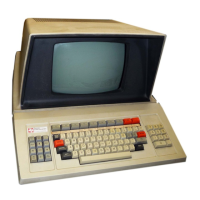~-------
"i:'.(
945424-9701
All cursor commands
except
A and I affect only
the
cursor position and provide no additional
information. Cursor commands, A and I, cause
the
current cursor address
to
be read and
rliQnl~::nrPrl
~nil
~
llrnu
thP
nnPr~tnr
tn
<;;nPrifu
~nu
mPmnru
lnr~tinn
(
ili"nfoupif
nr
nnt
rliQnl~uPill ~Q
-
....
"-".t"'
...
-J
--
_
.......
- _
...
_..
........
,.
.........
-
.......
r
.........
-"'
..........
"''-'
ur--
.......
J _
......
J ........ - .... &
...........
J
..........
--
....................
,-
.........
t'
....
-J
-~
.....,
...
.&
...
.....,
...
-
...
-l'"'
....
-J
--/
-"-"
the
new cursor location. Cursor command, A, permits a new
entry
after each cursor move
operation. The cursor command, I, continuously writes
the
operator-selected cursor address
into
the
controller register.
Modify
VDT
Memory/Scope
Loop
Verb (CD). The
Modify
VDT Memory/Scope Loop Verb (CD
verb) assists
the
operator
in
the
isolation
of
a system
or
unit fault. The CD verb allows
the
operator
to
modify
the
data
at
the
current cursor address which may
point
to
any
address
(displayed
or
not
displayed) in VDT memory. The CD verb can also activate useful routines for
scoping. The CD verb has five commands, as follows:
• S - Read
or
read and modify
memory
character
at
current cursor address.
• R - Read
or
read and modify
memory
character at
current
cursor address and move
cursor right
one
position.
• F - Free form
input
mode.
• SL - Modify and read data at cursor address.
• C - Exercise
CRU
interface.
• D - Write
pattern
to
screen (Japanese Katakana model only).
The
command
S aliows the
operator
to
read
memory
data
at
the
current cursor address and
to
write new
data
at
that
location
without
changing
the
cursor address.
The
data
in
the
read
data
register following this operation is
the
result
of
a
CRU
data
transfer,
not
an actual
memory
read
operation. Figure
2-3
illustrates
the
entry
of
the
five CD verb commands.
The
command
R. reads
the
memory
contents
at
the
current cursor address and allows the
operator
to
modify
the
memory
contents
at
that
location. The command
then
increments
the
cursor address and reads again.
The
command.
F permits free-form
input
to
the
screen from
the
terminal's keyboard. The
command
is initiated from
the
hot
mock-up system's 733.
The
command
SL reads refresh memory at
the
current cursor address and allows
the
operator
to
modify
memory
at
that
location (memory write). Following acceptance
or
modification
of
the
data
byte,
the
program continuously cycles performing a write followed
by
an increment and
decrement
of
the
cursor address
to
cause memory read operations. This
loop
permits scoping
of
a
memory
pattern.
The
command
C exercises
the
CRU address bits (and word select circuitry) in a tight loop for
scoping.
2-6
Digitai
Systems Division

